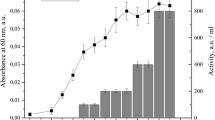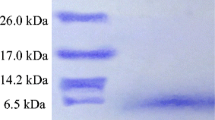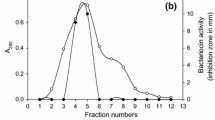Abstract
Enterococcus sp. 812, isolated from fresh broccoli, was previously found to produce a bacteriocin active against a number of Gram-positive bacteria, including Listeria monocytogenes. Bacteriocin activity decreased slightly after autoclaving (121 °C for 15 min), but was inactivated by protease K. Mass spectrometry analysis revealed the bacteriocin mass to be approximately 4,521.34 Da. N-terminal amino acid sequencing yielded a partial sequence, NH2-ATYYGNGVYXDKKKXWVEWGQA, by Edman degradation, which contained the consensus class IIa bacteriocin motif YGNGV in the N-terminal region. The obtained partial sequence showed high homology with some enterococcal bacteriocins; however, no identical peptide or protein was found. This peptide was therefore considered to be a novel bacteriocin produced by Enterococcus sp. 812 and was termed enterocin T.




Similar content being viewed by others
References
Bennik MH, Vanloo B, Brasseur R, Gorris LG, Smid EJ (1998) A novel bacteriocin with a YGNGV motif from vegetable-associated Enterococcus mundtii: full characterization and interaction with target organisms. Biochim Biophys Acta 1373:47–58
Chen YS, Liou MS, Ji SH, Yu CR, Pan SF, Yanagida F (2013) Isolation and characterization of lactic acid bacteria from Yan-tsai-shin (fermented broccoli stems), a traditional fermented food in Taiwan. J Appl Microbiol 115:125–132
De Man JD, Rogosa M, Sharpe ME (1960) A medium for the cultivation of lactobacilli. J Appl Bacteriol 23:130–135
Drider D, Fimland G, Héchard Y, McMullen LM, Prévost H (2006) The continuing story of class IIa bacteriocins. Microbiol Mol Biol Rev 70:564–582
Du L, Somkuti GA, Renye JA Jr (2012) Molecular analysis of the bacteriocin-encoding plasmid pDGL1 from Enterococcus durans and genetic characterization of the durancin GL locus. Microbiology 158:1523–1532
Eguchi T, Kaminaka K, Shima J, Kawamoto S, Mori K, Choi SH, Doi K, Ohmomo S, Ogata S (2001) Isolation and characterization of enterocin SE-K4 produced by thermophilic enterococci, Enterococcus faecalis K-4. Biosci Biotechnol Biochem 65:247–253
Eijsink VG, Axelsson L, Diep DB, Håvarstein LS, Holo H, Nes IF (2002) Production of class II bacteriocins by lactic acid bacteria; an example of biological warfare and communication. A Review. Antonie Van Leeuwenhoek 81:639–654
Ennahar S, Aoude-Werner D, Assobhei O, Hasselmann C (1998) Antilisterial activity of enterocin 81, a bacteriocin produced by Enterococcus faecium WHE 81 isolated from cheese. J Appl Microbiol 85:521–526
Ennahar S, Sonomoto K, Ishizaki A (1999) Class IIa bacteriocins from lactic acid bacteria: antibacterial activity and food preservation. J Biosci Bioeng 87:705–716
Franz CM, van Belkum MJ, Holzapfel WH, Abriouel H, Gálvez A (2007) Diversity of enterococcal bacteriocins and their grouping in a new classification scheme. FEMS Microbiol Rev 31:293–310
Gálvez A, Valdivia E, Abriouel H, Camafeita E, Mendez E, Martínez-Bueno M, Maqueda M (1998) Isolation and characterization of enterocin EJ97, a bacteriocin produced by Enterococcus faecalis EJ97. Arch Microbiol 171:59–65
Garver KI, Muriana PM (1994) Purification and partial amino acid sequence of curvaticin FS47, a heat-stable bacteriocin produced by Lactobacillus curvatus FS47. Appl Environ Microbiol 60:2191–2195
Himeno K, Fujita K, Zendo T, Wilaipun P, Ishibashi N, Masuda Y, Yoneyama F, Leelawatcharamas V, Nakayama J, Sonomoto K (2012) Identification of enterocin NKR-5-3C, a novel class IIa bacteriocin produced by a multiple bacteriocin producer, Enterococcus faecium NKR-5-3. Biosci Biotechnol Biochem 76:1245–1247
Jennes W, Dicks LM, Verwoerd DJ (2000) Enterocin 012, a bacteriocin produced by Enterococcus gallinarum isolated from the intestinal tract of ostrich. J Appl Microbiol 88:349–357
Leong KH, Chen YS, Lin YH, Pan SF, Yu B, Wu HC, Yanagida F (2013) Weissellicin L, a novel bacteriocin from sian-sianzih-isolated Weissella hellenica 4-7. J Appl Microbiol 115:70–76
Lin YH, Chen YS, Wu HC, Pan SF, Yu B, Chiang CM, Chiu CM, Yanagida F (2013) Screening and characterization of LAB-produced bacteriocin-like substances from the intestine of grey mullet (Mugil cephalus L.) as potential biocontrol agents in aquaculture. J Appl Microbiol 114:299–307
Lohans CT, Huang Z, van Belkum MJ, Giroud M, Sit CS, Steels EM, Zheng J, Whittal RM, McMullen LM, Vederas JC (2012) Structural characterization of the highly cyclized lantibiotic paenicidin A via a partial desulfurization/reduction strategy. J Am Chem Soc 134:19540–19543
Nishie M, Nagao J, Sonomoto K (2012) Antibacterial peptides “bacteriocins”: an overview of their diverse characteristics and applications. Biocontrol Sci 17:1–16
Sánchez J, Diep DB, Herranz C, Nes IF, Cintas LM, Hernández PE (2007) Amino acid and nucleotide sequence, adjacent genes, and heterologous expression of hiracin JM79, a sec-dependent bacteriocin produced by Enterococcus hirae DCH5, isolated from Mallard ducks (Anas platyrhynchos). FEMS Microbiol Lett 270:227–236
Srionnual S, Yanagida F, Lin LH, Hsiao KN, Chen YS (2007) Weissellicin 110, a newly discovered bacteriocin from Weissella cibaria 110, isolated from plaa-som, a fermented fish product from Thailand. Appl Environ Microbiol 73:2247–2250
Svetoch EA, Stern NJ, Eruslanov BV, Kovalev YN, Volodina LI, Perelygin VV, Mitsevich EV, Mitsevich IP, Pokhilenko VD, Borzenkov VN, Levchuk VP, Svetoch OE, Kudriavtseva TY (2005) Isolation of Bacillus circulans and Paenibacillus polymyxa strains inhibitory to Campylobacter jejuni and characterization of associated bacteriocins. J Food Prot 68:11–17
Tomita H, Fujimoto S, Tanimoto K, Ike Y (1996) Cloning and genetic organization of the bacteriocin 31 determinant encoded on the Enterococcus faecalis pheromone-responsive conjugative plasmid pYI17. J Bacteriol 178:3585–3593
Yanagida F, Chen YS, Onda T, Shinohara T (2005) Durancin L28-1A, a new bacteriocin from Enterococcus durans L28-1, isolated from soil. Lett Appl Microbiol 40:430–435
Yang R, Johnson MC, Ray B (1992) Novel method to extract large amounts of bacteriocins from lactic acid bacteria. Appl Environ Microbiol 58:3355–3359
Acknowledgments
The authors would like to thank the National Science Council Taiwan for financially supporting this study through a grant to Shwu-fen Pan (Contract No. NSC 101-2313-B-130-001).
Author information
Authors and Affiliations
Corresponding author
Additional information
Communicated by Djamel Drider.
Rights and permissions
About this article
Cite this article
Chen, Ys., Yu, Cr., Ji, Sh. et al. Enterocin T, a novel class IIa bacteriocin produced by Enterococcus sp. 812. Arch Microbiol 195, 655–660 (2013). https://doi.org/10.1007/s00203-013-0917-3
Received:
Revised:
Accepted:
Published:
Issue Date:
DOI: https://doi.org/10.1007/s00203-013-0917-3




